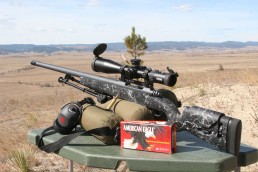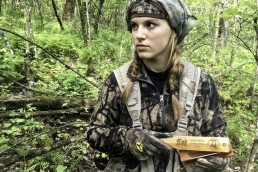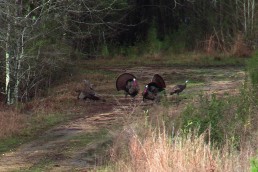Montana Rifles: Model 1999 Professional Hunter part two
SHARE THIS POST
Setting up with my hand-loaded Sierra TK 250-grain bullets, Federal brass and RL 19 on the 1,000-yard range, I had my bench rest table on the 100-foot bluff above the valley that retained the Action Target (AT) E-50 silhouette. With dry ground and the dust, I’d be able to pick up trace hits in the form of bullet splash or hit contacts with ease. This makes the Model 1999, in its heavy tactical variant, an outstanding ultra-long-range rifle when you’re shooting alone, and in my case, lacking a spotter.
With a loaded chamber, I checked the wind that I had previously measured at 10 to 15 mph. It was almost full value left to right, and by pushing two milrads into it and then making an elevation adjustment of 7 mils, I sent round number one through this handcrafted masterpiece.
In what seemed forever, I waited with my crosshairs dead center on the E-50 steel target. Almost three seconds went by when I was greeted by a bullet splash in a cloud of gray, dried gumbo, which indicated I had shot off the very right edge of the upper torso-sized steel target. Elevation was good, but the stiff crosswind required a bit more advancement in terms of mils graduations.
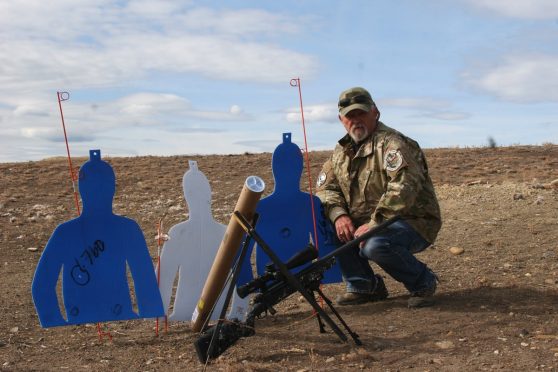
Sighting for a second time, I now advanced to an additional 3/10 of a mil, but maintained the very same elevation of 7 mils. When the Timney trigger cut the sear and lifted off its 3 pounds of trigger weight, the second bullet was on its way to the 1,000-yard steel. Wait and hold was the order, and after a bit of time, the earth erupted all across the big steel plate and angled toward the ground to prevent any bullet deflection. The bullet had hit a bit low, but well centered on the target. The dust and splash had been the big 250-grain Match King bullet, coming apart all across the ground at the face of the target.
With this system on dry ground, hits are easy to spot, even though I have the outstanding Vortex spotting scope at hand for a detailed look at the freshly painted target surface, when required. Seven more rounds and three additional hits confirmed that the Montana Model 1999 and 338 Lapua was right at home to over one-half mile downrange.
Day number two saw another set of obstacles that were somewhat of a challenge for the Montana super- rifle. The winds aloft at 100 feet above the valley floor were gusting up to 25 mph when I arrived on-site. I was thinking of packing the whole thing up for the day, as I noticed not only that the winds were crazy at the muzzle, but there was also an obvious directing switch of 90 degrees, at about 800 yards out. With a velocity judging by two wind flags in the area of about 20 mph, this was going to be trick shooting at the least.
I had hand-loaded a new load that I was intended to run downrange that morning. I set up, at least for nothing less than to get some feel for a new IMR 7977 load of 94.6 grains behind the 250-grain Sierra MK bullet. This recommended load by my friend Kris Hodgon of the Hodgon Powder Company was right off the drawing board in terms of driving big bullets in the 338 Lapua.
The new load picked up a full 200-fps increase downrange from the previous RL 19. And with these conditions cutting the hang time (time of bullet flight from muzzle to the target), it would aid in the fight with the crosswinds I was now about to face. I want to be clear in this case: the RL 19 was a downloaded round and was designed expressly for long-range whitetail hunting during the fall. It could’ve been moved up in grain weight, but as usual, I was in the testing mode. And with the hotter loads in hand, the IMR 7977 propellant got the call.
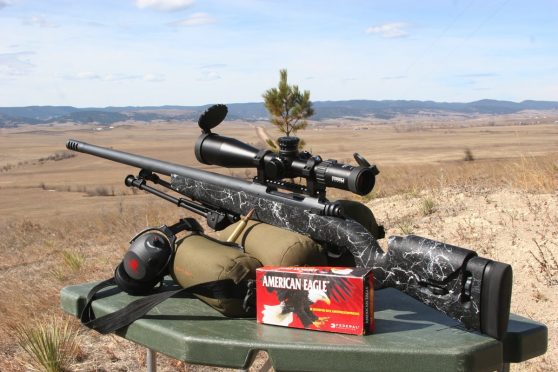
Even though long ranges and wind don’t mix, if more bullets and more powder can come to the rescue, so much the better. Now on hold and waiting for the drop of the gusting 25-mph winds, I was locked down on the bags with my safety off and eyes in the glass. At a reduced wind velocity to about 18 mph, I ran the same sight picture as the prior RL 19 load, and then touched off the Montana Model 1999. After a several-second time delay, the bullet erupted into a cloud of dust about 5 yards beyond the steel target, indicating a steep drift of 2 yards to the right. My theory was that the bullet had traveled farther and was being pushed by wind for a longer period of time, which transferred to more bullets drifting. I could’ve been all wet using this theory, but it felt right at the time as I now pushed for another two mils into the variable full-value wind and had also dropped a full mil off my elevation.
With the second round sent downrange, the dust exploded across the face of the big E 50 target plate, indicating a solid hit on steel. Even when shooting a rifle like the Montana Model 1999, there is the element of horse sense and a gut-level feeling that tends to come into play often when sending bullets through a wind storm at a very long range.
You could say that I learned to shoot from lessons given over by a U.S. Navy, and heavy cruiser, 8-inch gun. I could elaborate on this, but the fact is that long-range rifle work is a great deal like naval guns shooting at targets several miles downrange. Also, factor in the firing solution, send a round, and then spot that round and correct for impact. Mr. Metzger, my old friend and colleague at Shot Data Systems in New Brighton, Minn., was on a heavy cruiser during the Korean War and they tried to and hit a truck on a bridge at 8 miles as they pounded positions ahead of our troops. As Mr. Metzger stated, “One high, one low, and the next one on target.”
Are you enjoying this post?
You can be among the first to get the latest info on where to go, what to use and how to use it!
Not a great deal different from sending rounds with the Montana/338 Lapua super-gun in many ways. But if I have visual projectile splash, the target is going to get hit.
Going long
Up to now we had been shooting the Montana Model 1999 at close range, but not even close to what this rifle will actually deliver when checking into the next zip code. Just to make things interesting, I elected to turn to my Birchwood Casey “Blue Man” half-torso targets and a mock trench mortar setup as if I was being advanced on. While I don’t play video games, I do like some element of realism when applying a rifle/ cartridge like the 338 Lapua to a death at a distance target. With three torso targets down behind a hand- made cardboard mortar, I set up the whole deal at 1,400 yards, which was confirmed by my Leica 2000 Rangefinder.
First, the developing DOPE (data on previous engagement) rolled out of my handheld smartphone ballistics app in seconds. While I didn’t expect the bullet impact figures to be exact—as everything is in constant change on the prairie—I did figure that I’d be able to hit close enough to pick up my bullet’s splash then adjust my exact hold from that point on. With my Blue Man targets set in a pocket that consisted of prairie dog mounts and almost no vegetation at all, a dust cloud would be somewhat easy to pick out lacking a spotter, especially with the ultra-accurate, heavyweight, long-range rifle that was in use.
The firing solution (DOPE) indicated that I should maintain a 16 1/2-mil holdover. With an angling wind at about 30 degrees right to left, I pulled for 2 mils, which took my crosshairs to the far right side of the cluster of cardboard. Now, disengaging the Model 70 style safety and pulling the Model 1999’s butt stock into my shoulder solid, but not tight, I maintained my sight picture and sent round one downrange. Three-plus seconds went by before the splash of the bullet turned up dirt directly over the far left cardboard member of the bad guy mortar team. I was about 3/10 of a mil high, and that was about the norm for the 4 percent down- angle that I was shooting from on the 100-foot elevated “Dead Horse Ridge.” I dropped my elevation less than half the measurement of a single mil, and then maintained the same wind hold when the Timney trigger cracked once again. The mortar tube came apart and the targeted Blue Man in the center of the group took the round almost dead center. When I make shots like that it’s like dusting a bull elk in my mind.
Over the next 10 rounds, four bullets found their marks. And with the mortar tube eliminated and two targets hit, I felt that the Model 1999 had done its job well considering the elevation and wind conditions.
Postscript
During my interviews and real-time email communications with on-location snipers over in the sand box, I have come to understand that many believe in the basic turn-bolt rifle with a very big cartridge in its chamber is far and above some others. Harsh conditions shut down some systems, and the more complicated they are the greater the risk of firearms failure can occur.
As I have illustrated here, the Montana Rifle Model 1999 is in my opinion one of those systems that won’t quit when the conditions get rough. Quality design, construction, materials and cartridge choice make this a true custom super-rifle for the next zip code type of field applications. I fully realize that the 338 Lapua, or even the equally effective Norma 338 Magnum, are not every shooter’s choice; these big cartridges cost a whole lot of money to buy or even handload and the paired rifles are not to be found on any bargain- basement store shelf. What I do know is that a rifle like this Montana creation is within a special class of “thunderstick.” These types of rifles were born out of a need to hold off some very nasty people. The end result is that success has been evident when a check is made of target scores or bad people being issued the number “86” in the field.
L.P. Brezny has worked in research and development across the shooting industry for 37 years. He has developed and marketed systems for 12 gauges, designed ammunition for Winchester and Federal Cartridge, designed separator quiet slugs, shotshells and one-choke do-it-all systems. Brezny was the first ballistics writer to measure shotgun pellets in flight to ranges as great as 100 yards. He has published three books on shooting (Gun Digest Books), and is completing a fourth on long-range rifle applications. He has published hundreds of articles on sending rounds downrange.
For more information…
The Model 1999 is available in 338 Lapua and 338 Norma Magnum. Learn more at montanarifleco.com.
MWO
SHARE THIS POST
Did you enjoy this post?
You can be among the first to get the latest info on where to go, what to use and how to use it!
L.P. Brezny
Writing on outdoor subjects for over 40 years, L.P. Brezny has written four books on shotgun and rifle (ballistics and performance). He’s an expert at smoothbore, and high-power, ultra-long-range shooting. He’s a specialist, producing reviews covering general products used in the outdoors industry.
